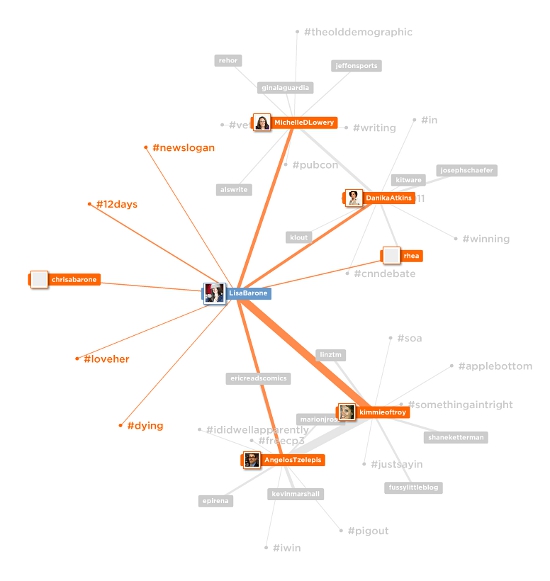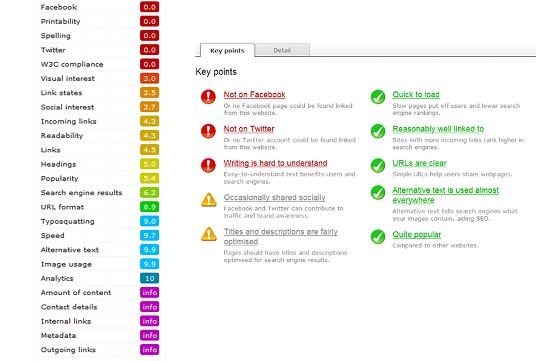We’re almost halfway through our 12 Days of Christmas—er, SEO—and I want use my day to talk about five golden link finds that can help your link development efforts. I know, I know, we do a link-up post each month, but this a different kind of list.
Golden Link #1
Mentionmapp is a simple tool to help you discover groups of people that Twitter users connect with the most. Simple: Enter a Twitter handle and watch a map of connections appear. Thicker lines indicate more interactions and recent mention between individuals.

Mentionmapp for Link Prospecting
If you’re always looking for new ways to build links, an immediate opportunity with Mentionmapp lies in discovering contact webs. Using the map, make a list of Twitter handles and corresponding websites (their profile information is displayed in the tool) in an Excel spreadsheet. Those who make the list are probably worth seeking a link from. After making a healthy list of prospects, run the Web sites of those prospects through a backlink service. If you use something like Open Site Explorer, export your backlinks to a new spreadsheet.
Run a backlink report for your domain. Now, compare the links to your domain with the link prospects you identified before. Remove the duplicates in Excel and what remains is a list of sites you want to attain backlinks from since they haven’t linked to you yet. Even better, you’ve got their Twitter handles. Consider setting up a list on Twitter to keep tabs on their activity and see where there’s an opportunity for you to request a link, provide content with a backlink, or develop potential partnerships.
If you’re not already following the people on that list, do so. Also, read Elf Emily’s post for Twitter n00bs if you need a little more help on getting the most out of Twitter.
Golden Link #2
Analyze Words is great because it helps you determine the personality of the Twitter handle you’re about to pitch. It does this by analyzing the words a Twitter account used most recently. Then it assigns sentiment and other psychographic labels to the Twitter account. Wouldn’t it be nice to know the personality of the person you’re about to pitch so you could better approach them? I’d like that, and this tool makes it easier to do so.

Golden Link #3
The free tools (they also have a paid suite) available from iSpionage are great for both quick and comprehensive competitive keyword and content intelligence.
SEO Data
With the SEO portion of their reports, you can get PageRank data quickly, along with a graph showing the number of pages a domain has in the top three spots on Google (as well as pages in the top ten).

Keyword Research Anyone?
In addition to interesting PPC and organic value data you can use to make something awesome, check out the related keywords that are generated (and delivered with search volume) for further keyword research:

The report helps you find new keywords, but takes it a step further and finds high-volume phrases your site isn’t targeting. Generate new content to support these phrases, and you’ll give your audience something that may have been missing.
Golden Link #4
While there are a handful of tools here, I chose to try their SiteBeam product. I can’t speak for the other tools on the site. What this tool does is analyze your Web site, and create a presentation or PDF based on the results.
I like it for two reasons. For the more seasoned SEO, it provides a lot of information and metrics in an easy-to-manage format—perfect for a very quick audit, but I’m not sure it should replace anything from an SEO purist standpoint. The second reason I’d use this is to help train newbies to understand some of the basics of an audit. Reason being, each metric it returns comes with a brief explanation as to why that metric is important. Using this tool, you get everything from SEO to social media to technical data to writing quality and spelling and more.

Why I Like it for Link Building
First off, this wouldn’t be my end-all tool for auditing a competitor’s site, but I could get a sense of what’s working for them—and against them—in a short amount of time. I’d use the reports to look at internal links and how they use anchor text to link pages, their popularity (including social metrics and inbound links). The incoming links tab pulls from SEOmoz data and gives me a paragraph summary as to how the tool thinks their link strategy is working. Again, my best advice for using this tool is for a quick and dirty audit to provide initial insight, and as a teaching aid for those new to the industry. This is especially true if you’re trying to teach the importance of, and connection between, on-page factors being synergistic with link building and social efforts.
Golden Link #5
Wait a second! No link, you say?! Well, you’re right. Now that I’ve shared my link finds, tell us about one of your gems that you might not usually share with others. Come on, it’s the holiday season…share! Post your tool pick in the comments and let the conversation begin!
[This post is part of our 12 Days of SEO series where we’ll be publishing a different nugget of knowledge related to the sounds of the season. We’ll be updating the 12 Days of SEO page as new posts are published.]

